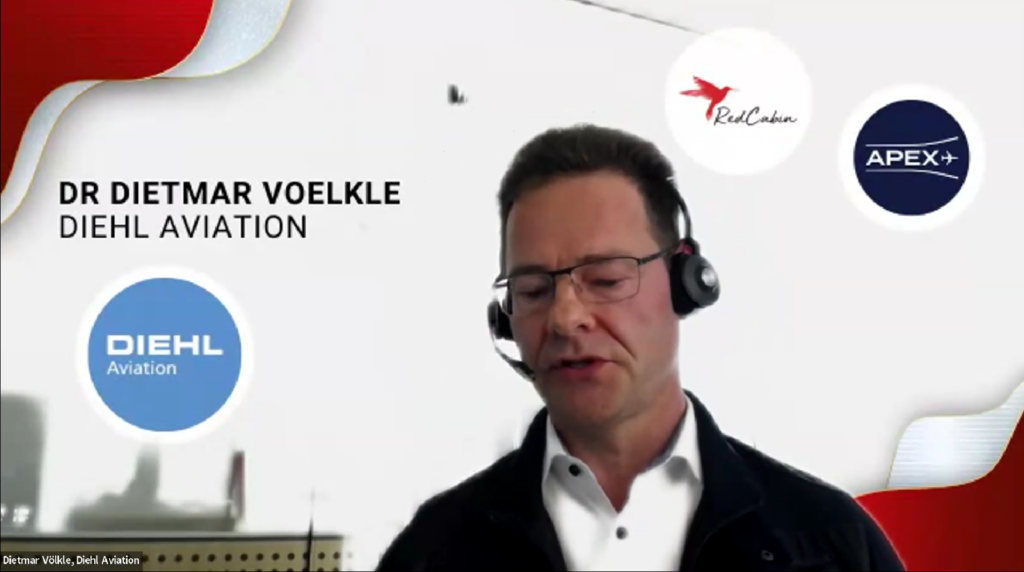Collaboration, Digitalization & Standardization Key to Faster Certification of Cabin Innovations, Say APEX/RedCabin Webinar Panelists
Share

An insightful webinar co-hosted by APEX CEO Dr. Joe Leader and RedCabin Founder and CEO Monica Wick this week saw senior leaders from airlines, OEMs and suppliers explore how to speed up the certification process for innovative new cabin interiors products.
Collaboration will Always be King
All panelists agreed that early collaboration between all relevant industry stakeholders is instrumental to success. They went on to outline the current way of working, whereby an airline or supplier approaches the relevant regulatory bodies with a new product so the latter can assess whether new industry standards need to be generated in response. The airline or supplier can then integrate these into their design and development processes moving forward.
“The timing of that engagement with [the regulator] is important,” said Andrew Keleher, Boeing Technical Fellow for Cabin Development, Engineering and Certification. “A new design needs to have reached a certain level of maturity for the regulator to understand and assess its key characteristics. If we took every innovation to the Federal Aviation Administration (FAA) very early in the development process, then it would be difficult for them to determine their priorities, but at the other end of the spectrum, if we wait until a product is fully designed the FAA may create new requirements we haven’t anticipated and in that case we’d have to go back and revise the design.”
“The early identification of the risks … gives our customers a degree of certainty that it can successfully manage the process without risking the overall execution of the project.”
Jose Pevida, ZIM Group
For Xia Cai, SVP Product Development & Design at Qatar Airways, internal collaboration across airlines is also important. “We have a very robust team internally … The [technical team] understand the key customer experience drivers, the level of hospitality that is the Qatar standard, and likewise we make sure that we embed safety and compliance into our earliest thinking. Bringing those two things together is never an afterthought.“
Jose Pevida, SVP Engineering & Product Development at ZIM Group, said that as a supplier, one technique his company has identified to streamline certification “is the early identification of the risks in a risk register, which encourages us to make this part of the developmental process.” He feels that together with design sprints and early testing, teams can retire the risk early on. “This gives our customers a degree of certainty that it can successfully manage the process without risking the overall execution of the project.”
In terms of speeding up new certifications for cabin interiors, Mike Thompson, Manager of the Cabin Safety Division at the FAA, explained that it has also set up a “new emerging technology coordination section, which is allowing [the FAA] to work on exciting new innovations prior to applications for certifications being submitted.” Although he noted that it is primarily being used for complex innovations like electric vertical take-off and landing (eVTOL) aircraft, Thompson continued, “They can work on interior design projects if they consider early engagement is needed and they’ll need to develop new standards and methods of compliances.”
Digitalization is the Future
Many of the panelists also extolled the virtues of digitalization. Dr. Dietmar Voelkle, VP Research at Diehl Aviation said the industry had to “trust that the ability to come to new procedures is possible,” citing digital simulation as central to the incorporation of sustainable materials in future cabin interior designs.

He went on to mention progressing the use of “more autonomized testing methods … like differentials scanning … to assess the flammability or the heat release capabilities of materials much faster.” Voelkle concluded, “There are solutions there, and I’m always looking out for robot-assisted mechanical testing.”
Lars Lehmann, Head of Engineering for Cabin & Cargo Architecture and Technology at Airbus also championed digitalization. He said, “There won’t ever be a full replacement of mockups and physical testing, but to de-risk and ensure we get it right first time, a more systematic approach is critical for us as an industry.”
More Needs to be Done to Harmonize Regulations
Cai is of the opinion that “the industry has the best of intentions when it comes to supporting innovations.” However, following a question from the audience regarding the certification of a heating and cooling system for aircraft seats, technology which is already broadly available in the automotive industry, Masroor Hasan, SVP of Aircraft Programs at Qatar Airways commented, “We are not catching up to the consumer market fast enough.”
One of the reasons he cited is that any new product has to be certified separately by the FAA, the European Union Aviation Safety Agency (EASA) and via the vendor’s internal system, all of which can have conflicting requirements.
“We are not catching up to the consumer market fast enough.”
Masroor Hasan, Qatar Airways
Thompson said that harmonizing the certification process between different regulatory bodies is something the FAA is working on; and Lehmann agreed it was important. He added, “Doing this will make life easier for all of us. We have examples where the FAA and EASA are already co-operating, like agreeing that Technical Standard Orders (TSOs) are a common reference point, but I would encourage the authorities to go further in this direction.”
Lehmann also advocated for what he called “true digital continuity” throughout the certification process, which he defined as “supporting certification-relevant traceability of requirements, for example, from concept to certification, from single-parts vendor to the certification bodies.” He believes this form of standardization and digitalization could speed up the certification process for more complex products and innovations.


